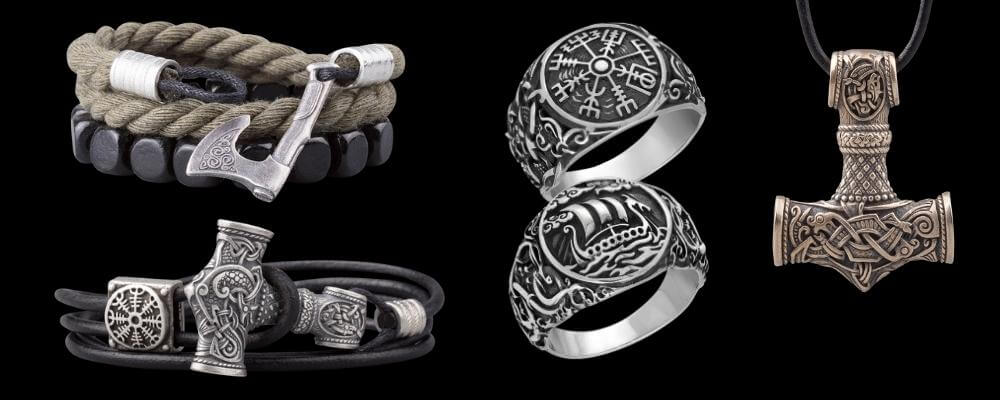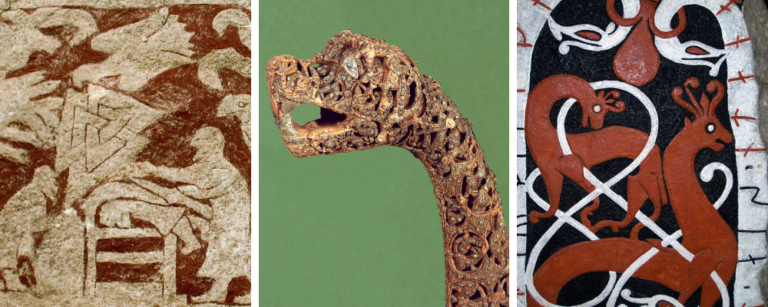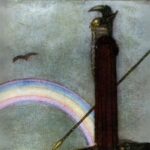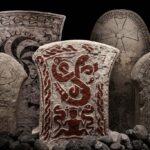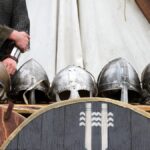While we tend to think of the Vikings as raiders and warriors, we should not forget that this was just one element of a sophisticated culture that also had music, science, religion, and, of course, visual art.
Like most cultures, the Vikings created beautiful things out of many different materials. However, due to the inevitable decay of time, most of the surviving Viking art available to us is in stone and metal. So, basically, monumental pieces and jewelry.
Scraps of Viking art survive on other materials, such as wood and textiles, so we know that they also worked in these materials, but complete examples do not survive.
But from what has survived to the modern-day, let’s take a look at what we do know about Viking art.
A Note on Tattoos
Lots of people ask about traditional Viking tattoos, so it is worth saying something here.
We don’t have any surviving examples of Viking tattoos. This would require a body where the skin is preserved, such as a bog burial or a mummy, and we just don’t have these for the Vikings.

It is generally believed that the Vikings did tattoo themselves, as the Arabic scholar Ahmed Iban Fadlan described the Vikings that he encountered in Russia in the 10th century as “dark” from the tips of their toes to the tops of their necks, with pictures of trees and the like.
It is notable that other sources, for example, Anglo-Saxon sources that do comment on Viking appearance, don’t make mention of tattoos. However, we know that the Anglo-Saxons also tattooed themselves, so perhaps they just didn’t think that it was worth mentioning.
In short, we don’t know what Viking tattoos looked like, and we need to speculate based on their art. And like Viking art, tastes will have changed over time, and would have been different in different areas of the Viking world.

Traditional Viking Art
You could spend a lifetime studying Viking art. It changed and evolved over a period of four centuries from the 8th to the 12th centuries, and it differs depending on where you are in the Viking world. But there are a few themes that are present across the board.

Symbols
The Vikings had a lot of symbols, and they feature extensively in their art. They helped imbue the artwork with meaning and helped the viewer decipher the artwork.
For example, the presence of a spear or a hammer would help you determine whether the god depicted is meant to be Odin or Thor. Similarly, the presence of the Valknut could indicate that the scene depicts a warrior ascending to Valhalla.
Gods and Heroes
There are many Viking images that feature the gods, and sometimes heroes and other humans. Notably, the Viking images are usually two-dimensional. The gods always appear in profile, much like in Egyptian art. Though, obviously, statuettes provide a 3D view.
Animals
Animals feature heavily in Viking art, as both symbols and decorative motifs. In the latter case, it was common to extend the bodies of the animals into long sinuous strands which would then wrap around one another to form patterns.
Snakes and wolves, no doubt referencing Jormungandr and Fenrir, the monstrous children of Loki and Angrboda, are among the most popular animals depicted.
But many animals appear in Viking art including ravens, horses, bears, and others.
Ribboning
While animal bodies were often used to create a ribboning decorative effect, this was also done separately and is a key component of the Viking artistic style.
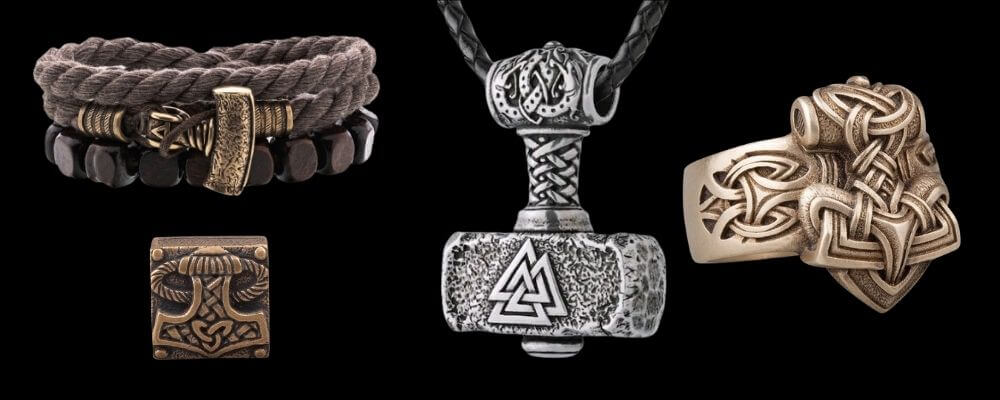
Viking Art Periods
As we have already said, Viking art was not identical throughout the Viking period and across the Viking territory. It changes over time and different styles were popular in different places.

It is possible to label scores of different artistic styles within the Viking world, but a few are more prevalent and important than others.
Oseberg
This style of art takes its name from the Oseberg Ship grave found in Vestfold in Norway, which preserved many examples of this artistic style. It is considered the earliest Viking art style, dating from the end of the 8th century.
Popular throughout mainland Scandinavia, it is generally characterized by beasts elongated into ribboning animals, and gripping themselves in their mouths to close up patterns.
Borre
The Borre style is named for artifacts found in the Borre mound cemetery, also in Vestfold, Norway. It was popular throughout Scandinavia, and is also found in Britain and the Baltic, from the mid 9th to the early 10th centuries.
The ribboning is tighter in this style of art, creating a knot-like effect.
Jelling
The Jelling style starts in the 10th century and was popular in Denmark. It is named for a series of pieces found in Jelling, Jutland.
It is marked out by the animal ribboning forming distinctive S-shape forms. Beaded dots also become popular within this style.
Mammen
The Mammen style feels like a clear evolution of the Jelling style, and is named for pieces found in a burial mound in Mammen, Jutland. It was popular from the mid 10th to the early 11th centuries.
What distinguishes this style is that many of the animal ribbons end in loose, curling tendrils. Other geometric shapes are also used to segment different parts of the animal bodies.
Ringerike
The Ringerike style is named for a decorated sandstone that was found in a northern district of Oslo in Norway. It was popular in that area from the end of the 10th to the middle of the 11th century.
It is very similar to the Mammen style, but the ribboning is more tightly composed. You also see a lot more birds and beasts featured in works during this period.

Urnes
The Urnes style is considered the last phase of Viking art and was popular from the mid 11th century until the early 12th century. It is named after the northern gate of the Urnes church in Norway, but many objects of this style have also been found in Uppland in Sweden.
The animals that form this artwork are distinguishable because they have almond-shaped eyes, and upwardly curled appendages on their noses and necks.
Read more about our jewelry store reviews and find out more interesting things about Viking art!
